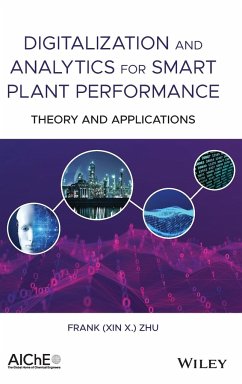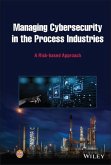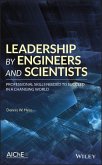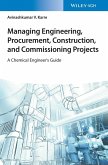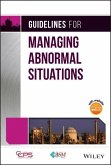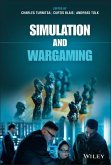- Gebundenes Buch
- Merkliste
- Auf die Merkliste
- Bewerten Bewerten
- Teilen
- Produkt teilen
- Produkterinnerung
- Produkterinnerung
This book addresses the topic of integrated digitization of plants on an objective basis and in a holistic manner by sharing data, applying analytics tools and integrating workflows via pertinent examples from industry. It begins with an evaluation of current performance management practices and an overview of the need for a "Connected Plant" via digitalization followed by sections on "Connected Assets: Improve Reliability and Utilization," "Connected Processes: Optimize Performance and Economic Margin " and "Connected People: Digitalizing the Workforce and Workflows and Developing Ownership…mehr
Andere Kunden interessierten sich auch für
![Managing Cybersecurity in the Process Industries Managing Cybersecurity in the Process Industries]() Center for Chemical Process Safety (CCPS)Managing Cybersecurity in the Process Industries157,99 €
Center for Chemical Process Safety (CCPS)Managing Cybersecurity in the Process Industries157,99 €![Leadership by Engineers and Scientists Leadership by Engineers and Scientists]() Dennis W. HessLeadership by Engineers and Scientists75,99 €
Dennis W. HessLeadership by Engineers and Scientists75,99 €![Managing Engineering, Procurement, Construction, and Commissioning Projects Managing Engineering, Procurement, Construction, and Commissioning Projects]() Avinashkumar V. KarreManaging Engineering, Procurement, Construction, and Commissioning Projects79,00 €
Avinashkumar V. KarreManaging Engineering, Procurement, Construction, and Commissioning Projects79,00 €![Guidelines for Managing Abnormal Situations Guidelines for Managing Abnormal Situations]() Center for Chemical Process Safety (CCPS)Guidelines for Managing Abnormal Situations133,99 €
Center for Chemical Process Safety (CCPS)Guidelines for Managing Abnormal Situations133,99 €![Root Cause Failure Analysis Root Cause Failure Analysis]() Trinath SahooRoot Cause Failure Analysis141,99 €
Trinath SahooRoot Cause Failure Analysis141,99 €![Simulation and Wargaming Simulation and Wargaming]() C TurnitsaSimulation and Wargaming129,99 €
C TurnitsaSimulation and Wargaming129,99 €![Guidelines for Evaluating Process Plant Buildings for External Explosions, Fires, and Toxic Releases Guidelines for Evaluating Process Plant Buildings for External Explosions, Fires, and Toxic Releases]() Center for Chemical Process Safety (CCPS)Guidelines for Evaluating Process Plant Buildings for External Explosions, Fires, and Toxic Releases129,99 €
Center for Chemical Process Safety (CCPS)Guidelines for Evaluating Process Plant Buildings for External Explosions, Fires, and Toxic Releases129,99 €-
-
-
This book addresses the topic of integrated digitization of plants on an objective basis and in a holistic manner by sharing data, applying analytics tools and integrating workflows via pertinent examples from industry. It begins with an evaluation of current performance management practices and an overview of the need for a "Connected Plant" via digitalization followed by sections on "Connected Assets: Improve Reliability and Utilization," "Connected Processes: Optimize Performance and Economic Margin " and "Connected People: Digitalizing the Workforce and Workflows and Developing Ownership and Digital Culture," then culminating in a final section entitled "Putting All Together Into an Intelligent Digital Twin Platform for Smart Operations and Demonstrated by Application cases."
Produktdetails
- Produktdetails
- Verlag: Wiley & Sons / Wiley-AIChE
- Artikelnr. des Verlages: 1W119634030
- 1. Auflage
- Seitenzahl: 544
- Erscheinungstermin: 23. März 2021
- Englisch
- Abmessung: 235mm x 157mm x 33mm
- Gewicht: 878g
- ISBN-13: 9781119634034
- ISBN-10: 1119634032
- Artikelnr.: 59920243
- Herstellerkennzeichnung
- Libri GmbH
- Europaallee 1
- 36244 Bad Hersfeld
- gpsr@libri.de
- Verlag: Wiley & Sons / Wiley-AIChE
- Artikelnr. des Verlages: 1W119634030
- 1. Auflage
- Seitenzahl: 544
- Erscheinungstermin: 23. März 2021
- Englisch
- Abmessung: 235mm x 157mm x 33mm
- Gewicht: 878g
- ISBN-13: 9781119634034
- ISBN-10: 1119634032
- Artikelnr.: 59920243
- Herstellerkennzeichnung
- Libri GmbH
- Europaallee 1
- 36244 Bad Hersfeld
- gpsr@libri.de
Frank (Xin X.) Zhu, PhD, is Senior Engineering Fellow and Leader of Engineering Innovations at Honeywell UOP. He has made significant contributions to the theoretical framework, the computational tools, and applications in the fields of data analytics, production planning, operation scheduling, process modeling, design and optimization. He has published seminal journal articles and widely used books especially in the areas of process operations, process design and energy systems. He holds 68 US patents, is the co-founder and chair of ECI International Conference: CO 2 Summit, and the recipient of prestigious AICHE Energy Sustainability Award.
Preface xiii
Acknowledgments xvii
Part 1 Challenges and Opportunities For Digitalization 1
1 Challenges for Operation Excellence 3
1.1 Introduction 3
1.2 Operation Activities in a Process Plant 4
1.3 The Major Challenges Facing the Industries 5
1.4 The Methodology of Connected Plant 11
1.5 Digitalization Enabling Connected Plant 12
1.6 What is the Digitalization Journey? 18
1.7 Overview of the Book Structure 19
References 21
2 Mission of Connected Plant 23
2.1 What is Connected Plant? 23
2.2 Major Functions of Connected Plant 24
2.3 Digital Twins: The Core of Connected Plant 27
2.4 Conclusions 32
References 33
3 Data Analytics for Operation Excellence 35
3.1 Introduction 35
3.2 Process Data Overview: Characteristics and Attributes 37
3.3 Unique Attributes of Process Data Analytics 39
3.4 Model Types and Characteristics 40
3.5 First Principle Modeling and its Characteristics 42
3.6 Statistic Modeling and its Characteristics 45
3.7 Optimization Models 47
3.8 Artificial Intelligence (AI) and Machine Learning (ML) Models 50
3.9 Put All Together: Digital Twin as a Data Science Platform 55
References 59
Part 2 Model Thinking For Smart Operations 63
4 Statistics Basics 65
4.1 Introduction 65
4.2 Normal Distribution 65
4.3 Conditional Probability 72
4.4 Bayes' Probability 73
4.5 Statistic Tests 75
References 84
5 Advanced Statistic Modeling 85
5.1 Introduction 85
5.2 Distribution Models 85
5.3 Correlation Models 94
5.4 Advanced Modeling Techniques 101
5.5 Data Mining 106
5.6 Summary 107
References 107
6 Rigorous Process Modeling 109
6.1 Introduction 109
6.2 Reaction Kinetic Modeling 110
6.3 Reactor Types and Modeling 126
6.4 Integrated Kinetics and Reactor Modeling 131
6.5 Catalyst Deactivation Root Causes and Modeling 135
6.6 Distillation Modeling 136
6.7 Process System Modeling and Simulation 138
6.8 Separation Technology Overview 142
References 144
7 Linear Optimization Modeling 147
7.1 Introduction 147
7.2 Linear Optimization for Planning 148
7.3 How to Deal with Nonlinear Terms? 151
7.4 Delta Vector as Linear Approximation of Nonlinear Yield Models 154
7.5 Successive Linear Programing (SLP) Approach 159
References 160
8 Nonlinear Optimization Modeling 161
8.1 Introduction 161
8.2 Successive Quadratic Programming (SQP) Approach 162
8.3 Local Versus Global Optimum 162
8.4 Optimality Conditions 166
8.5 Nonlinear Process Optimization Model 167
8.6 Stochastic Programming 171
8.7 Simulation-Based Optimization 178
8.8 A Case Study for Process Optimization 180
8.9 Concluding Remarks 188
References 190
9 Process Control and APC Modeling 193
9.1 Introduction 193
9.2 Process Modeling in Control 194
9.3 Regulatory Control: Managing Individual Variables 207
9.4 PID Controller Modeling 211
9.5 Advanced Process Control (APC) 221
References 233
10 AI and Machine Learning Modeling 235
Amit Gupta and Frank (Xin X.) Zhu
10.1 Introduction 235
10.2 Artificial Neural Networks 235
Acknowledgments xvii
Part 1 Challenges and Opportunities For Digitalization 1
1 Challenges for Operation Excellence 3
1.1 Introduction 3
1.2 Operation Activities in a Process Plant 4
1.3 The Major Challenges Facing the Industries 5
1.4 The Methodology of Connected Plant 11
1.5 Digitalization Enabling Connected Plant 12
1.6 What is the Digitalization Journey? 18
1.7 Overview of the Book Structure 19
References 21
2 Mission of Connected Plant 23
2.1 What is Connected Plant? 23
2.2 Major Functions of Connected Plant 24
2.3 Digital Twins: The Core of Connected Plant 27
2.4 Conclusions 32
References 33
3 Data Analytics for Operation Excellence 35
3.1 Introduction 35
3.2 Process Data Overview: Characteristics and Attributes 37
3.3 Unique Attributes of Process Data Analytics 39
3.4 Model Types and Characteristics 40
3.5 First Principle Modeling and its Characteristics 42
3.6 Statistic Modeling and its Characteristics 45
3.7 Optimization Models 47
3.8 Artificial Intelligence (AI) and Machine Learning (ML) Models 50
3.9 Put All Together: Digital Twin as a Data Science Platform 55
References 59
Part 2 Model Thinking For Smart Operations 63
4 Statistics Basics 65
4.1 Introduction 65
4.2 Normal Distribution 65
4.3 Conditional Probability 72
4.4 Bayes' Probability 73
4.5 Statistic Tests 75
References 84
5 Advanced Statistic Modeling 85
5.1 Introduction 85
5.2 Distribution Models 85
5.3 Correlation Models 94
5.4 Advanced Modeling Techniques 101
5.5 Data Mining 106
5.6 Summary 107
References 107
6 Rigorous Process Modeling 109
6.1 Introduction 109
6.2 Reaction Kinetic Modeling 110
6.3 Reactor Types and Modeling 126
6.4 Integrated Kinetics and Reactor Modeling 131
6.5 Catalyst Deactivation Root Causes and Modeling 135
6.6 Distillation Modeling 136
6.7 Process System Modeling and Simulation 138
6.8 Separation Technology Overview 142
References 144
7 Linear Optimization Modeling 147
7.1 Introduction 147
7.2 Linear Optimization for Planning 148
7.3 How to Deal with Nonlinear Terms? 151
7.4 Delta Vector as Linear Approximation of Nonlinear Yield Models 154
7.5 Successive Linear Programing (SLP) Approach 159
References 160
8 Nonlinear Optimization Modeling 161
8.1 Introduction 161
8.2 Successive Quadratic Programming (SQP) Approach 162
8.3 Local Versus Global Optimum 162
8.4 Optimality Conditions 166
8.5 Nonlinear Process Optimization Model 167
8.6 Stochastic Programming 171
8.7 Simulation-Based Optimization 178
8.8 A Case Study for Process Optimization 180
8.9 Concluding Remarks 188
References 190
9 Process Control and APC Modeling 193
9.1 Introduction 193
9.2 Process Modeling in Control 194
9.3 Regulatory Control: Managing Individual Variables 207
9.4 PID Controller Modeling 211
9.5 Advanced Process Control (APC) 221
References 233
10 AI and Machine Learning Modeling 235
Amit Gupta and Frank (Xin X.) Zhu
10.1 Introduction 235
10.2 Artificial Neural Networks 235
Preface xiii
Acknowledgments xvii
Part 1 Challenges and Opportunities For Digitalization 1
1 Challenges for Operation Excellence 3
1.1 Introduction 3
1.2 Operation Activities in a Process Plant 4
1.3 The Major Challenges Facing the Industries 5
1.4 The Methodology of Connected Plant 11
1.5 Digitalization Enabling Connected Plant 12
1.6 What is the Digitalization Journey? 18
1.7 Overview of the Book Structure 19
References 21
2 Mission of Connected Plant 23
2.1 What is Connected Plant? 23
2.2 Major Functions of Connected Plant 24
2.3 Digital Twins: The Core of Connected Plant 27
2.4 Conclusions 32
References 33
3 Data Analytics for Operation Excellence 35
3.1 Introduction 35
3.2 Process Data Overview: Characteristics and Attributes 37
3.3 Unique Attributes of Process Data Analytics 39
3.4 Model Types and Characteristics 40
3.5 First Principle Modeling and its Characteristics 42
3.6 Statistic Modeling and its Characteristics 45
3.7 Optimization Models 47
3.8 Artificial Intelligence (AI) and Machine Learning (ML) Models 50
3.9 Put All Together: Digital Twin as a Data Science Platform 55
References 59
Part 2 Model Thinking For Smart Operations 63
4 Statistics Basics 65
4.1 Introduction 65
4.2 Normal Distribution 65
4.3 Conditional Probability 72
4.4 Bayes' Probability 73
4.5 Statistic Tests 75
References 84
5 Advanced Statistic Modeling 85
5.1 Introduction 85
5.2 Distribution Models 85
5.3 Correlation Models 94
5.4 Advanced Modeling Techniques 101
5.5 Data Mining 106
5.6 Summary 107
References 107
6 Rigorous Process Modeling 109
6.1 Introduction 109
6.2 Reaction Kinetic Modeling 110
6.3 Reactor Types and Modeling 126
6.4 Integrated Kinetics and Reactor Modeling 131
6.5 Catalyst Deactivation Root Causes and Modeling 135
6.6 Distillation Modeling 136
6.7 Process System Modeling and Simulation 138
6.8 Separation Technology Overview 142
References 144
7 Linear Optimization Modeling 147
7.1 Introduction 147
7.2 Linear Optimization for Planning 148
7.3 How to Deal with Nonlinear Terms? 151
7.4 Delta Vector as Linear Approximation of Nonlinear Yield Models 154
7.5 Successive Linear Programing (SLP) Approach 159
References 160
8 Nonlinear Optimization Modeling 161
8.1 Introduction 161
8.2 Successive Quadratic Programming (SQP) Approach 162
8.3 Local Versus Global Optimum 162
8.4 Optimality Conditions 166
8.5 Nonlinear Process Optimization Model 167
8.6 Stochastic Programming 171
8.7 Simulation-Based Optimization 178
8.8 A Case Study for Process Optimization 180
8.9 Concluding Remarks 188
References 190
9 Process Control and APC Modeling 193
9.1 Introduction 193
9.2 Process Modeling in Control 194
9.3 Regulatory Control: Managing Individual Variables 207
9.4 PID Controller Modeling 211
9.5 Advanced Process Control (APC) 221
References 233
10 AI and Machine Learning Modeling 235
Amit Gupta and Frank (Xin X.) Zhu
10.1 Introduction 235
10.2 Artificial Neural Networks 235
Acknowledgments xvii
Part 1 Challenges and Opportunities For Digitalization 1
1 Challenges for Operation Excellence 3
1.1 Introduction 3
1.2 Operation Activities in a Process Plant 4
1.3 The Major Challenges Facing the Industries 5
1.4 The Methodology of Connected Plant 11
1.5 Digitalization Enabling Connected Plant 12
1.6 What is the Digitalization Journey? 18
1.7 Overview of the Book Structure 19
References 21
2 Mission of Connected Plant 23
2.1 What is Connected Plant? 23
2.2 Major Functions of Connected Plant 24
2.3 Digital Twins: The Core of Connected Plant 27
2.4 Conclusions 32
References 33
3 Data Analytics for Operation Excellence 35
3.1 Introduction 35
3.2 Process Data Overview: Characteristics and Attributes 37
3.3 Unique Attributes of Process Data Analytics 39
3.4 Model Types and Characteristics 40
3.5 First Principle Modeling and its Characteristics 42
3.6 Statistic Modeling and its Characteristics 45
3.7 Optimization Models 47
3.8 Artificial Intelligence (AI) and Machine Learning (ML) Models 50
3.9 Put All Together: Digital Twin as a Data Science Platform 55
References 59
Part 2 Model Thinking For Smart Operations 63
4 Statistics Basics 65
4.1 Introduction 65
4.2 Normal Distribution 65
4.3 Conditional Probability 72
4.4 Bayes' Probability 73
4.5 Statistic Tests 75
References 84
5 Advanced Statistic Modeling 85
5.1 Introduction 85
5.2 Distribution Models 85
5.3 Correlation Models 94
5.4 Advanced Modeling Techniques 101
5.5 Data Mining 106
5.6 Summary 107
References 107
6 Rigorous Process Modeling 109
6.1 Introduction 109
6.2 Reaction Kinetic Modeling 110
6.3 Reactor Types and Modeling 126
6.4 Integrated Kinetics and Reactor Modeling 131
6.5 Catalyst Deactivation Root Causes and Modeling 135
6.6 Distillation Modeling 136
6.7 Process System Modeling and Simulation 138
6.8 Separation Technology Overview 142
References 144
7 Linear Optimization Modeling 147
7.1 Introduction 147
7.2 Linear Optimization for Planning 148
7.3 How to Deal with Nonlinear Terms? 151
7.4 Delta Vector as Linear Approximation of Nonlinear Yield Models 154
7.5 Successive Linear Programing (SLP) Approach 159
References 160
8 Nonlinear Optimization Modeling 161
8.1 Introduction 161
8.2 Successive Quadratic Programming (SQP) Approach 162
8.3 Local Versus Global Optimum 162
8.4 Optimality Conditions 166
8.5 Nonlinear Process Optimization Model 167
8.6 Stochastic Programming 171
8.7 Simulation-Based Optimization 178
8.8 A Case Study for Process Optimization 180
8.9 Concluding Remarks 188
References 190
9 Process Control and APC Modeling 193
9.1 Introduction 193
9.2 Process Modeling in Control 194
9.3 Regulatory Control: Managing Individual Variables 207
9.4 PID Controller Modeling 211
9.5 Advanced Process Control (APC) 221
References 233
10 AI and Machine Learning Modeling 235
Amit Gupta and Frank (Xin X.) Zhu
10.1 Introduction 235
10.2 Artificial Neural Networks 235

